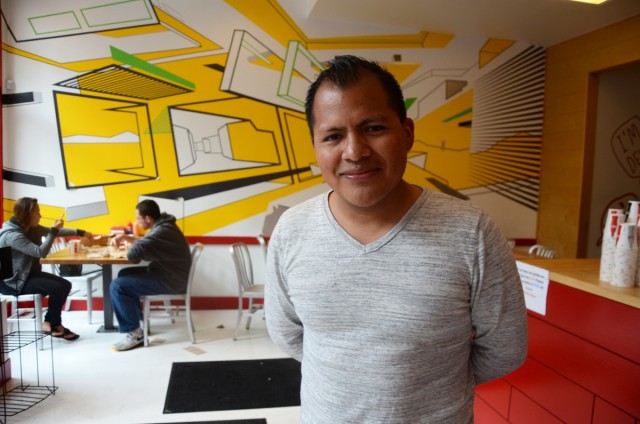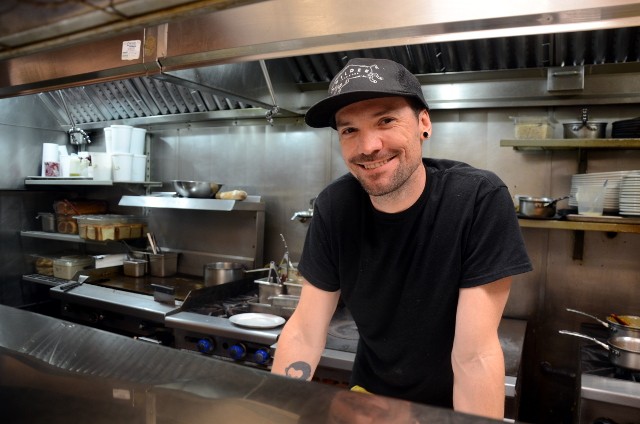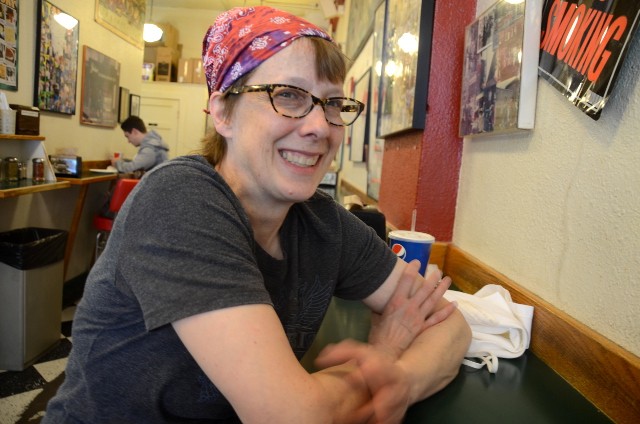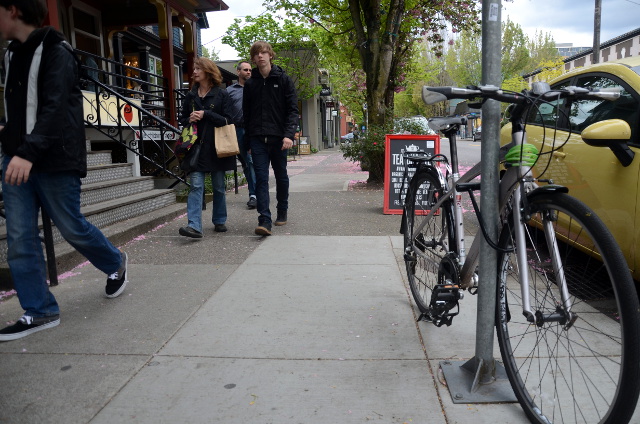
(Photos: M.Andersen/BikePortland)
Part of NW Portland Week.
Almost every map or chart you will ever see of “where people commute by bike” is incomplete.
Nineteen times out of 20, it’s based on only half of the picture: the locations people commute from. In the United States, we make almost no effort to calculate where people are bike-commuting to.
Little-known fact: according to the best data available, almost nowhere in Portland brings in a larger percentage of its commuters by bicycle than the lower section of Northwest 21st and 23rd, between Marshall and Burnside.
You can only find this information in an obscure Census dataset maintained by the association of state transportation engineers. But according to that estimate, about one in 10 of the 3,000-odd people who work on these 24 city blocks got there by bike during the years 2006-2010, the most recent available.
That’s double the estimated rates for the Lloyd District or downtown Portland.

(Data: CTPP 2006-2010. Chart: BikePortland.)
One in 10 employees of this little Census tract isn’t actually a lot of bike commuters: just a few hundred, barely enough to fill a secure bike parking area at Portland State University. That’s why nobody notices them.
But hidden in the fact that the Northwest District has a large share of bike commuters is an important fact about bike transportation in general.
To be sure, Portland has changed a lot since this data was collected. But take a walk or ride through this little corner of northwest Portland and you’ll see the sort of employers that don’t often make headlines as bike-commuting powerhouses, but are secretly the bedrock of American bike commuting: neighborhood retailers.
More specifically: bars and restaurants.
One in 10 Portland jobs (and one in 11 jobs nationwide) is some form of food service. And across the United States, an estimated 2.9 percent of people who work at “eating and drinking places” get to their jobs by bicycle. The only major employer category that comes close to that level of bike commuting are colleges and universities.
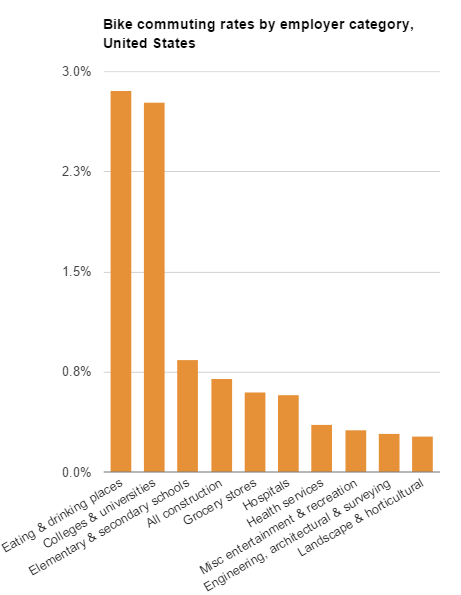
You’ll almost never see this fact mentioned by pro-bike politicians, urban planners, biking advocates or journalists, who love to talk about tech workers. But the combination of low-ish incomes, odd hours, youth and (probably) an affinity for after-work hijinks has made food service workers the footsoldiers of American bicycle transportation.
And that’s made the lower Northwest District, a dense hub of bars and restaurants with mediocre transit and terrible parking, a significant Portland bike commuting destination despite the area’s near-total lack of bike infrastructure.
It’s enough to make you wonder how much biking there would be if the bike infrastructure were actually improved.
Advertisement
On Tuesday afternoon I walked down 23rd from Overton toward Burnside, asking in each shop if any employees were bike commuters. Here are the first four bike commuters I met, in order.
Alfredo Reyes
Reyes, 27, has been the manager at Little Big Burger for three years. He was given his first bike by his father, a biking buff who once biked across several states in his native Mexico.
Reyes lives near Portland State University and is also taking business administration classes from Portland Community College. On one day, he has to get from class to Northwest in 10 minutes; on those days he drives his car. Other days, he bikes.
“I really love bikes, and I believe in sustainable cities and saving a lot of natural resources,” Reyes said. He added, self-deprecatingly: “Probably that’s my super liberal thing.”
Reyes said that when he gets “philosophical” about his commute, he bikes because of the “sense of freedom” — “you feel your own being,” he said.
Reyes mentioned that he’s also proud that his commute preserves urban space.
“I read an article that a car takes up 25 square feet,” he said. (Note: It’s probably more like 250, but it wasn’t important to his point.) “Times two for work and home. Times three for school. People in developing countries live in 50 square feet.”
Mark Nunziata
Nunziata, 35, is a barista at Barista, the award-winning coffee joint. He’s been biking in Portland since he first moved here in 2001 to attend PSU, and was soon involved in biking activism, “Critical Mass stuff.”
“It was a very different scene back then,” he said. Biking was his main transportation from then until 2005, when he moved home to Vermont for a few years. There, he got interested in motorcycles, and started building those into his commute when he returned to Portland in 2009.
He lives in north Portland and now usually uses truck and motorcycle, but just bought a “sweet new road bike” to bike-commute this summer.
“Being at work at 5:30 in the morning does not help your motivation to start pedaling when the truck and motorcycle are staring me in the face,” he confessed.
One of Nunziata’s main frustrations about bike-commuting to Nob Hill is the lack of comfortable east-west routes.
“I’ve done it tons of times and I still don’t think I’ve got a good way to get from the Steel Bridge across Naito and into Northwest Portland,” Nunziata said. “How cool would it be if we had a Going Street here? Stop signs, speed bumps — it’s almost like cars aren’t welcome. It’s great.”
Jason Elstad
Elstad, 34, is a cook at the cafe Papa Haydn. For the last three years, he’s been biking seven and a half miles each way to work from his home near 82nd and Fremont.
“I come in and I pass everybody who’s stuck in traffic, and I’m coming home and I pass everybody who’s stuck in traffic,” he said happily. “Not paying for parking is a huge bonus.”
A bike racer in his spare time, Elstad sometimes worries about parking his bike at work, which doesn’t offer secure bike parking. But he hasn’t had any problems yet.
Ann Greisser
Greisser, 52, works the counter at Escape from New York Pizza, a restaurant she started biking to as a customer more than 30 years ago. A Portland native, her first bike-commutes were to high school and Portland State University.
These days, she’s working two food service jobs, seven days a week. That includes four double shifts that keep her busy from 6 a.m. to 11 p.m.
“I bought a condominium and I’m just trying to work my savings back up,” she said. “I don’t mind working. I like where I work. These are casual places.”
Her late and early shifts mean she doesn’t have good public transit to and from the Pearl District home she bought after many years of saving. She could walk, but feels safer on a bicycle.
“You get your sketchers” when you’re a woman walking solo through northwest, Greisser said, especially after 11 p.m. Actual problems have been rare, but on the bike she can cruise past drunken frat boys and aggressive street dwellers alike.
Greisser says biking in Portland has gotten worse as the streets have gotten more crowded.
“I used to enjoy it more,” she said. “My friend and I would get off at 11 and we would do a night ride out to Sauvie Island. That was in the 90s.”
Today, Greisser described herself as “a cautious rider.”
“I can’t afford to get hurt,” she said.
— Michael Andersen, (503) 333-7824 – michael@bikeportland.org
Our work is supported by subscribers. Please become one today. .


